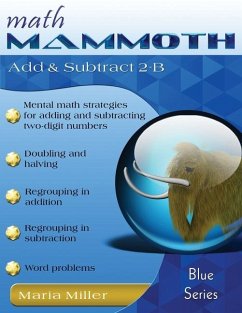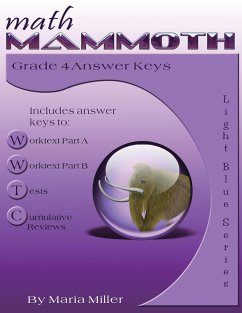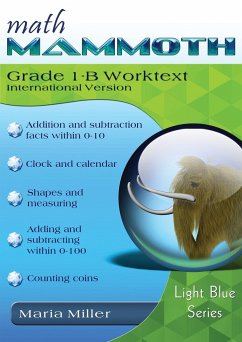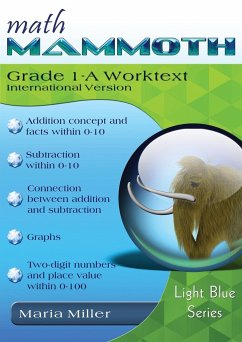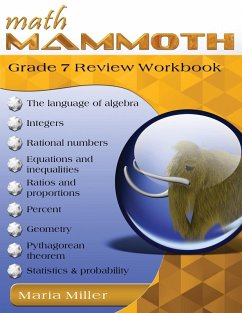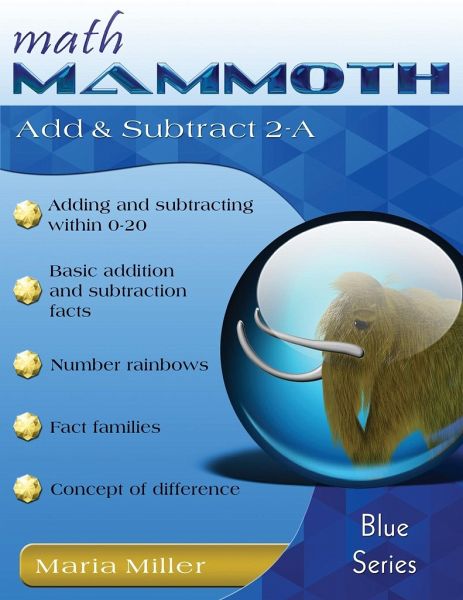
Math Mammoth Add & Subtract 2-A
Versandkostenfrei!
Versandfertig in 1-2 Wochen
18,99 €
inkl. MwSt.

PAYBACK Punkte
9 °P sammeln!
Math Mammoth Add & Subtract 2-A deals with two main themes: strategies for adding and subtracting within 0-20; such as adding just one more, a trick with nine and eight, and subtracting using addition; memorizing the basic addition and subtraction facts of single-digit numbers with an answer between 10 and 18. While focusing on addition and subtraction techniques, the lessons also include many word problems. The goal is to memorize the facts, or at least become so fluent with them that an outsider cannot tell if the child remembers the answer or uses some mental math strategy to get the answer...
Math Mammoth Add & Subtract 2-A deals with two main themes: strategies for adding and subtracting within 0-20; such as adding just one more, a trick with nine and eight, and subtracting using addition; memorizing the basic addition and subtraction facts of single-digit numbers with an answer between 10 and 18. While focusing on addition and subtraction techniques, the lessons also include many word problems. The goal is to memorize the facts, or at least become so fluent with them that an outsider cannot tell if the child remembers the answer or uses some mental math strategy to get the answer. Some children will accomplish this quicker and need less practice, whereas others will take longer. Thus, don't assign all the exercises in the book by default. Use your judgment, and try to match the amount of exercises to your child's need. The ones that don't get assigned can be used later for review. You can also use games to reinforce the facts, and in place of some of the exercises in the book (a list of games is provided in the book). Learning addition and subtraction facts is quite important for later study. For example, regrouping in addition and subtraction (carrying/borrowing) requires the ability to recall the basic facts efficiently and fluently. We will start the book with a few mental math strategies (Add Using "Just One More" and A Trick with Nine and Eight). The lesson Adding within 20 reviews those strategies and gives more practice. These initial lessons don't yet involve actual memorization techniques. The lesson Subtract to Ten explains another basic strategy, and has to do with subtracting in parts. For example, to do 13 ¿ 5, one can subtract 5 in two parts: first do 13 ¿ 3, which equals 10, and then subtract the rest, or 2 more. Memorizing the subtraction facts will be more efficient, but I want children to understand this strategy, because it is useful in many other situations also. Then we review how to complete the next whole ten, which is an important concept. An example of this concept is the question: What number do you add to 23 to get 30? As an equation, we write: 23 + __ = 30. In the next lesson, we study sums that go over ten, doing these sums in two parts. For example, in the sum 9 + 7, the child first completes 10 by adding 9 + 1. Then, the child adds the rest, or 6, to 10. Learning this prepares the child for addition facts where the sum is more than 10. The next lessons, Adding with 9, Adding with 8, Adding with 7, and Adding with 6, provide lots of practice for learning and memorizing the basic addition facts. There are 20 such facts: 9 + 2 till 9 + 9: 8 facts 8 + 3 till 8 + 8: 6 facts 7 + 4 till 7 + 7: 4 facts 6 + 5 till 6 + 6: 2 facts The last part of the book includes various lessons titled Number Rainbows and Fact Families with.... These give lots of practice and reinforcement for the basic addition and subtraction facts, emphasizing the connection between addition and subtraction as a strategy for subtraction facts. The follow-up to this book, Add & Subtract 2-B, practices adding and subtracting two-digit numbers mentally and in columns (regrouping).





